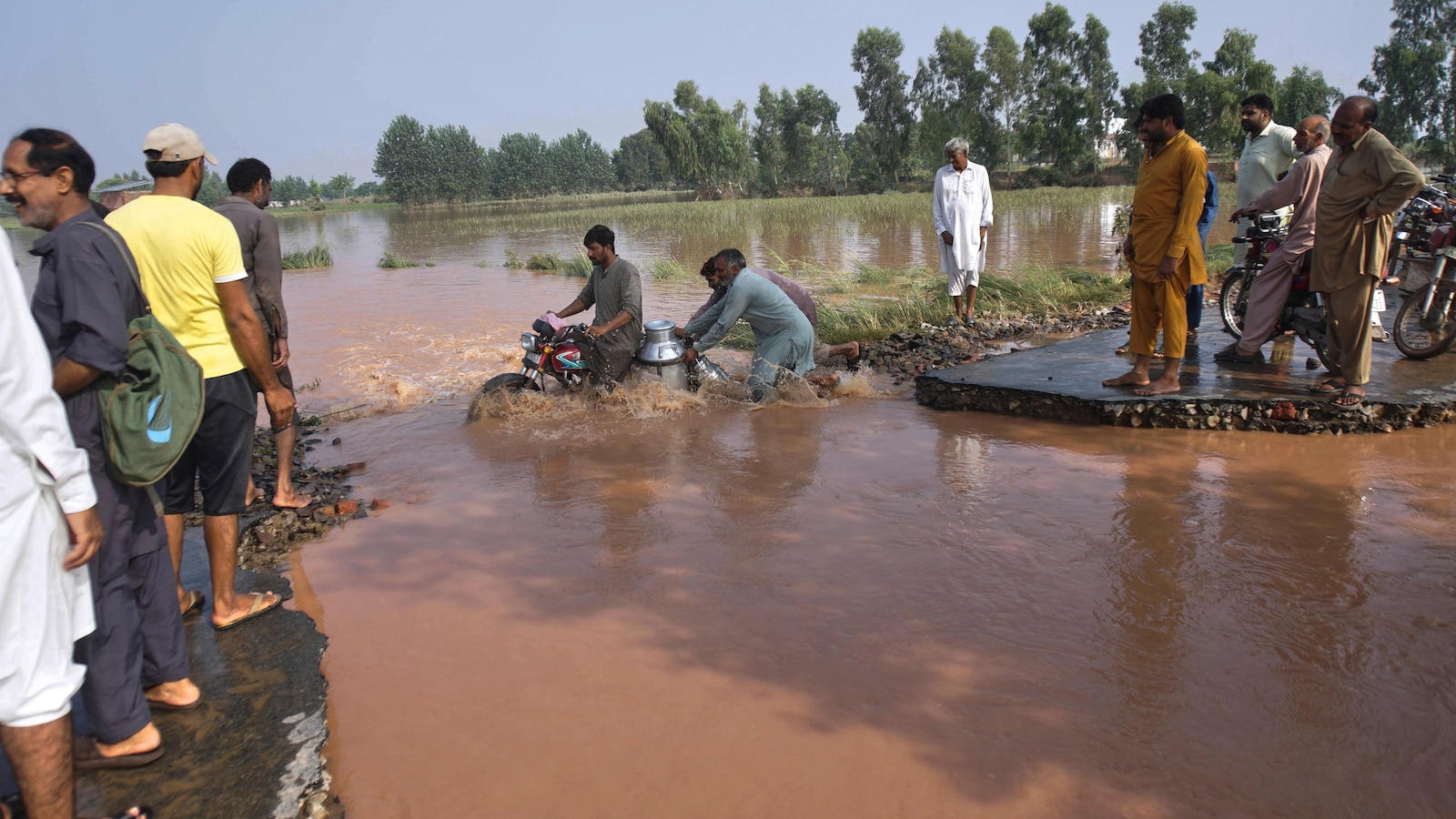Rescuers race to evacuate tens of thousands as floods overwhelm Pakistan’s eastern Punjab
Abnormal rains and sudden releases from upstream Indian dams have sent floodwaters into parts of Punjab, forcing nearly 300,000 people to flee while many remain without food or medical aid.
Rescuers race to evacuate tens of thousands as floods overwhelm Pakistan’s eastern Punjab
Abnormal rains and sudden releases from upstream Indian dams have sent floodwaters into parts of Punjab, forcing nearly 300,000 people to flee while many remain without food or medical aid.
NAROWAL, Pakistan — Rescuers raced Friday to evacuate tens of thousands of Pakistanis stranded by sudden floods in the country’s eastern Punjab province, as authorities struggled to deliver food, medicine and shelter to many isolated communities.
The floods began Monday after an abnormal amount of rain in upstream areas prompted sudden releases of water from Indian dams on the Sutlej, Chenab and Ravi rivers, officials said. The deluge, the first to hit parts of the region in four decades, swelled rivers and inundated towns and villages, cutting off roads and utilities and forcing mass evacuations across multiple districts.

"Floodwaters in Narowal and surrounding areas have left many communities isolated and in urgent need of food and medical supplies," said Irfan Ali Kathia, director general of the Punjab Disaster Management Authority. He said nearly 300,000 people had been evacuated from flood-hit areas since the flooding began, and that 1,100 relief and medical camps were operating across the province to provide temporary shelter and treatment.
At least 20 people have died in this week’s floods in Punjab, Kathia said, bringing the nationwide death toll to 820 since flash floods began affecting parts of Pakistan in late June. Authorities said they were establishing additional medical camps in hard-hit areas, but residents reported delays in the arrival of government assistance and shortages of necessities.
New Delhi alerted Islamabad last week about the potential for cross-border flooding, Pakistan officials said, after unusually heavy rainfall raised river levels. Officials in Pakistan have attributed the rapid rise in floodwaters to both the heavy rains and the sudden releases from upstream reservoirs on the Indian side of the border that feed the Sutlej, Chenab and Ravi river system.
Local officials and relief workers described chaotic scenes in low-lying districts where homes, crops and roads were submerged. Rescue teams have been working to move families to higher ground and bring supplies to people who have sheltered on rooftops or in trees. The flood surge has damaged crops and livestock in several agricultural areas, compounding concerns about food security for displaced families.
Authorities have deployed provincial disaster teams to coordinate evacuations and relief distribution, and additional medical personnel were being sent to bolster the camps that are treating injured and sick residents. Despite those efforts, many residents in villages and smaller towns said they remained without government help days after waters began rising.
"We have not received any government assistance yet," a resident in a flood-affected village outside Narowal said Friday. "There is no food, and those who are injured have no medicines."
The recent flooding adds to a string of severe weather events that have affected Pakistan since late June. Officials reported hundreds of deaths and large-scale displacement earlier in the summer when flash floods struck other parts of the country. The current emergency in eastern Punjab has focused attention on the immediate needs of displaced people and on the logistical challenges of reaching isolated areas where roads and bridges have been damaged or washed away.
Relief agencies and provincial authorities are attempting to set up more camps and to distribute food rations, clean water and medical supplies, but the scale of displacement and the extent of infrastructure damage have complicated the response. Provincial officials stressed the need for additional resources to sustain relief operations, particularly in remote areas where access remains difficult.
The governments of Pakistan and India have previously coordinated on transboundary water management and flood warning procedures, and Islamabad said it received an advance alert from New Delhi last week about likely water releases. Officials in Punjab have urged residents in vulnerable areas to move to higher ground and avail themselves of temporary shelters set up by disaster authorities.
As rescue operations continued, officials said they were conducting assessments of damage to homes, roads and agricultural land to inform recovery plans. The immediate priorities outlined by provincial authorities included search and rescue, restoring access to isolated communities, delivering emergency medical care, and ensuring the supply of food and drinking water to displaced populations.
Relief workers cautioned that the unfolding humanitarian needs could grow if the monsoon pattern continues to produce heavy rains in the weeks ahead. For now, authorities in Punjab emphasized that evacuations and relief distributions would remain the focus of their operations as teams race to reach those most in need.